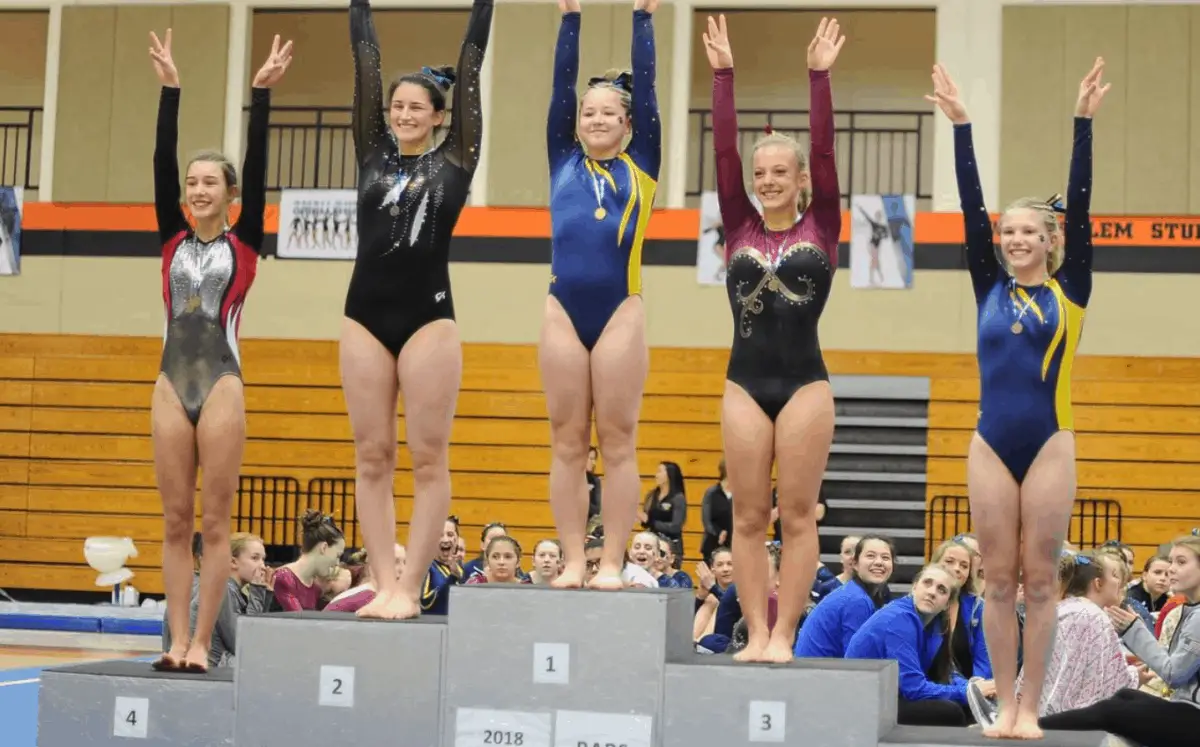If you are new when it comes to competing in a gymnastics meet, one of the first questions that you might be likely to have is about the rewards. The rewards are an area of gymnastics that is regulated in detail.
The number of awards given is dependent on the meet but normally the top 35-40% of the participants will receive an award. In some meets the top 3 receive a medal and 4th place on receive a ribbon. Awards are given at the end of each gymnastics meet to individuals as well as teams. Placement awards are given for each event and for the all-around, and there is also team awards.
However, there is a lot more about awards you might be wondering about. For example, there are specific protocols for if two gymnasts are tied. These rewards are given out in a certain order.
The Gymnastics Meets
Most often gymnastics competitions are held all day long. This means that there are several different meets that are scheduled one right after the other during the day. In the case of larger gyms, there may even be two different meets going on at the same time.
When this is done, the gymnasts from one meet are competing at one event while the gymnasts from the other meet are competing at one of the other events. The two meets may start at different times or the order of the events can be changed so that there is no conflict.

The different gymnastics meets are divided up into different levels. For example, the level 4 gymnasts will likely be the first level to compete when it comes to JO gymnastics. The higher levels like 5 through 10 are going to be later in the day the higher the level is.
This gives the gymnasts with the higher routines more time to prepare and warm up. In each of these meets, many coaches either line up their gymnasts by height or skill, with age factoring in a little as well.
In the case of height, the shorter gymnasts usually go first. But in the case of skill the better gymnasts often go last. This is why many times when you attend a gymnastics competition you may notice that some of the best scores are given out later on in the competition.
The Different Awards
In each of the different meets which, again, are done according to the level of the gymnasts, there are awards that are given out according to age groups. These groups are decided on according to how many gymnasts are in the meet.
This is so that the fewer gymnasts there are in a meet, the fewer age groups that meet will be divided into. This also means that with larger groups of gymnasts competing there are more awards that are given out.
Achievement Awards
There are achievement awards for each age division and for each event, and many gymnasts will get these. The way that you get these is that you simply have to get above a certain score, making them the most common award.
There are four different achievement awards that you can get, depending on how high you score. It you get a 9.00 or higher, you get a blue ribbon. A red ribbon is for scores between 8.00 to 9.00 and a white ribbon is for scores 7.50 to 8.00. Lastly, a yellow ribbon is for scores 7.00 to 7.50.
These are given for the individual events only, but there are all around achievement awards. While it is true that they have to give these out for state championships, other competitions do not require these to be given out.
When they are given out, the blue ribbon is for scores 35.00 with the red ribbon being from 33.00 to 35.00, the white ribbon being from 31.00 to 33.00, and the yellow ribbon from 29.00 up to the 31.00.
Placement Awards
The placement awards depend largely on how may gymnasts are competing in that age division. In the rare case that there is only one gymnast in a certain age division, the only award they get is 1st place in the all-around.
If there in somewhere between 2 and 10 gymnasts in the division, there is a 1st place award given for each event. A 1st and 2nd place reward is given out if there are only two gymnasts for the all around awards.
When there are 3 to 5 gymnasts, then a 1st through 3rd place reward is given for the all around with 4rth place being given if there are 6 to 10 gymnasts. From there, the placement awards continue to increase.
If there are 11 to 20 gymnasts in an age division, the individual events will have a 1st through 3rd event award. Meanwhile, the all around placement awards are given out for the gymnasts with the 6 highest all around scores.
From there up to 50 gymnasts, the individual events will have 1st through 6th places with 6 all around awards as well. Anything more than 50 gymnasts will get 10 placement awards for each event and 10 all around awards.
Other Rules And Protocols
One of the things that sometimes happen is that there can be a tie for one of the events. Depending on the level of the competition and what type of competition it is, both gymnasts can sometimes be declared to be tied in the same place and in this case a duplicate award is made and sent to one of the gymnasts.
More often, one of the gymnasts is given the reward that is lower. So, f they were tied for 1st place, then one of the gymnasts gets 1st place and the other one gets 2nd place.
When two gymnasts get the same score for the same event and tie for first place for the event, for example, then the gymnast who has the highest all around score in their other events wins the award. If their all around score is the same, then the decision is made by a flip of a coin.
If the score is tied for the all around score award, this tie is broken by taking a look at the gymnast’s scores for their individual events. The gymnast who has the highest single score wins the award in this case.
If they are still tied at this point, then the gymnast who has the second highest score wins. When the gymnasts are still tied at this point, the gymnast with the highest third score is the winner. However, in the rare event that this is not enough, the winner is decided by a flip of the coin.
As mentioned, there are both achievement awards and placement awards. When a gymnast gets awarded with a placement award then they do not get the achievement award. This is only for the first four levels, however, and the higher levels leave it to the State Administrative Committee.
A meet director is allowed to give out more awards than the ones that they are required to, but they are not allowed to give out less. For example, the State Administrative Committee has it in their power to add an achievement award for the all around scores as well as the individual events.
Conclusion
While this should be able to give you a pretty good idea of the rewards and how they are given out, there are still a lot of details that it would take too long to mention here. One example is the separate rules that cover event specialists who do not compete in some of the events at all.
All of this is not even mentioning the fact that there are team rewards. These are slightly more straightforward though. While they are not always given, when they are they are given to all members of the team.
Finally, one of the most important things for you to know about all of this is that there is a rule that says that any gymnast who competed in the wrong age division forfeits any rewards. This is to prevent older and more experienced gymnasts from competing with younger gymnasts.

